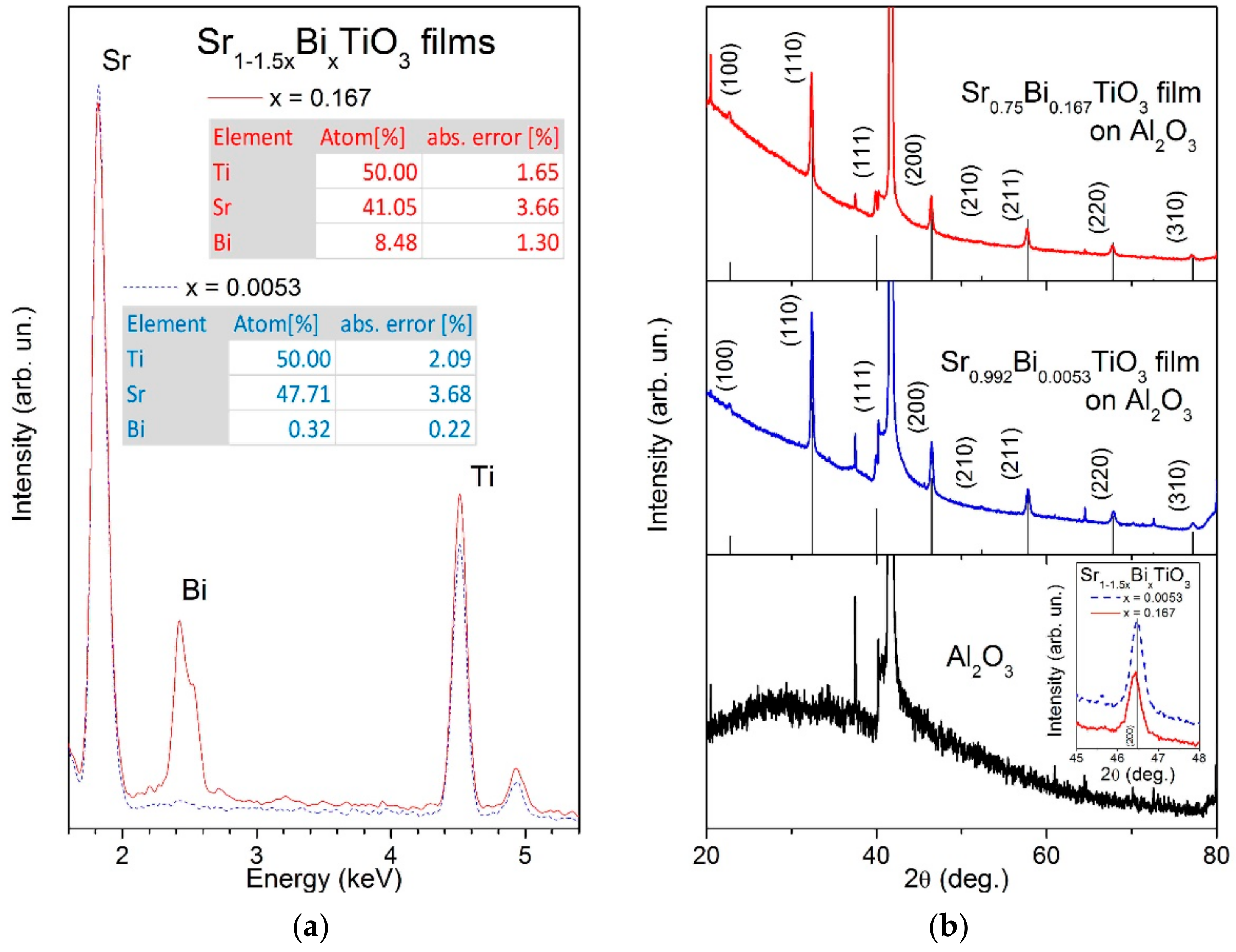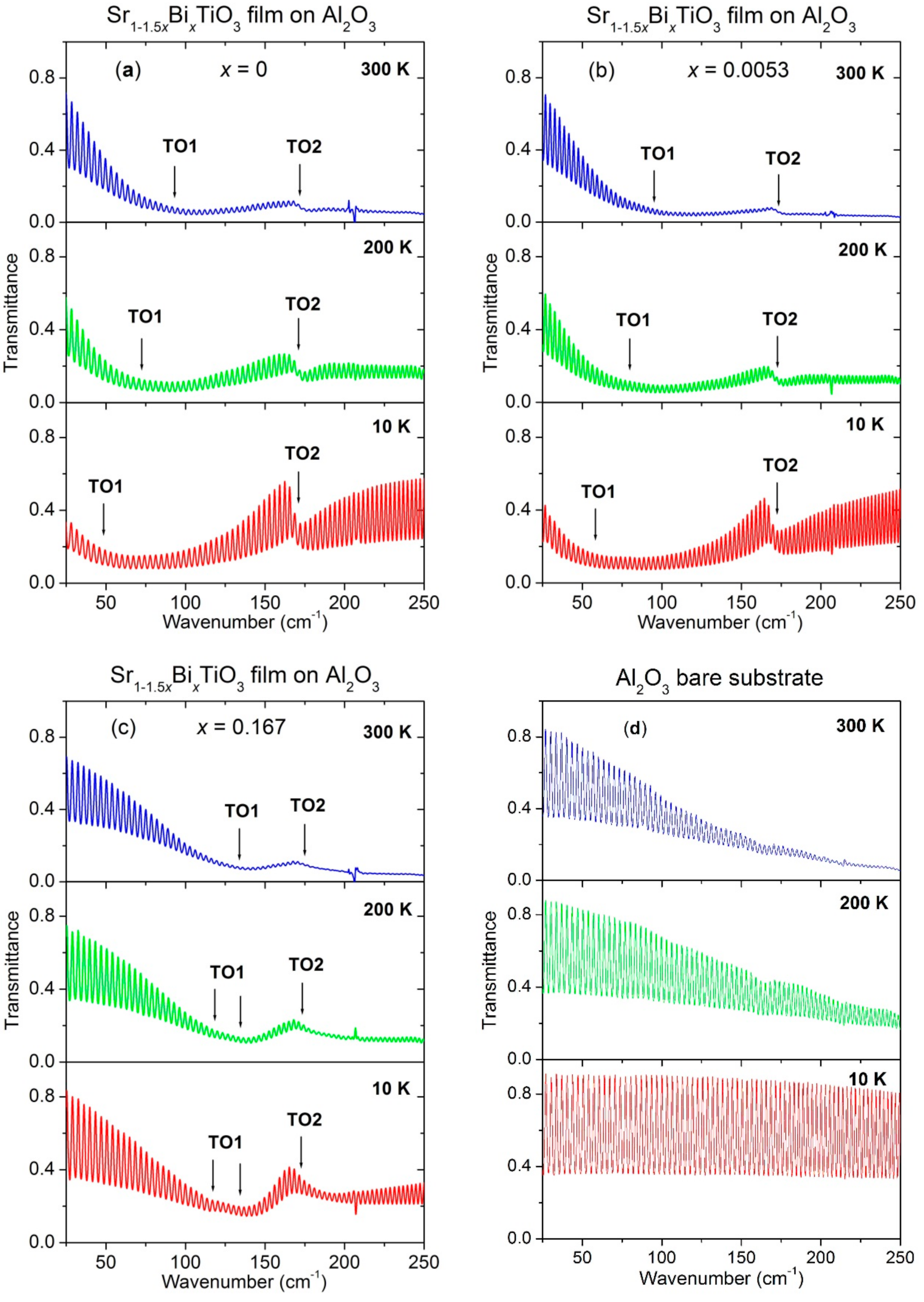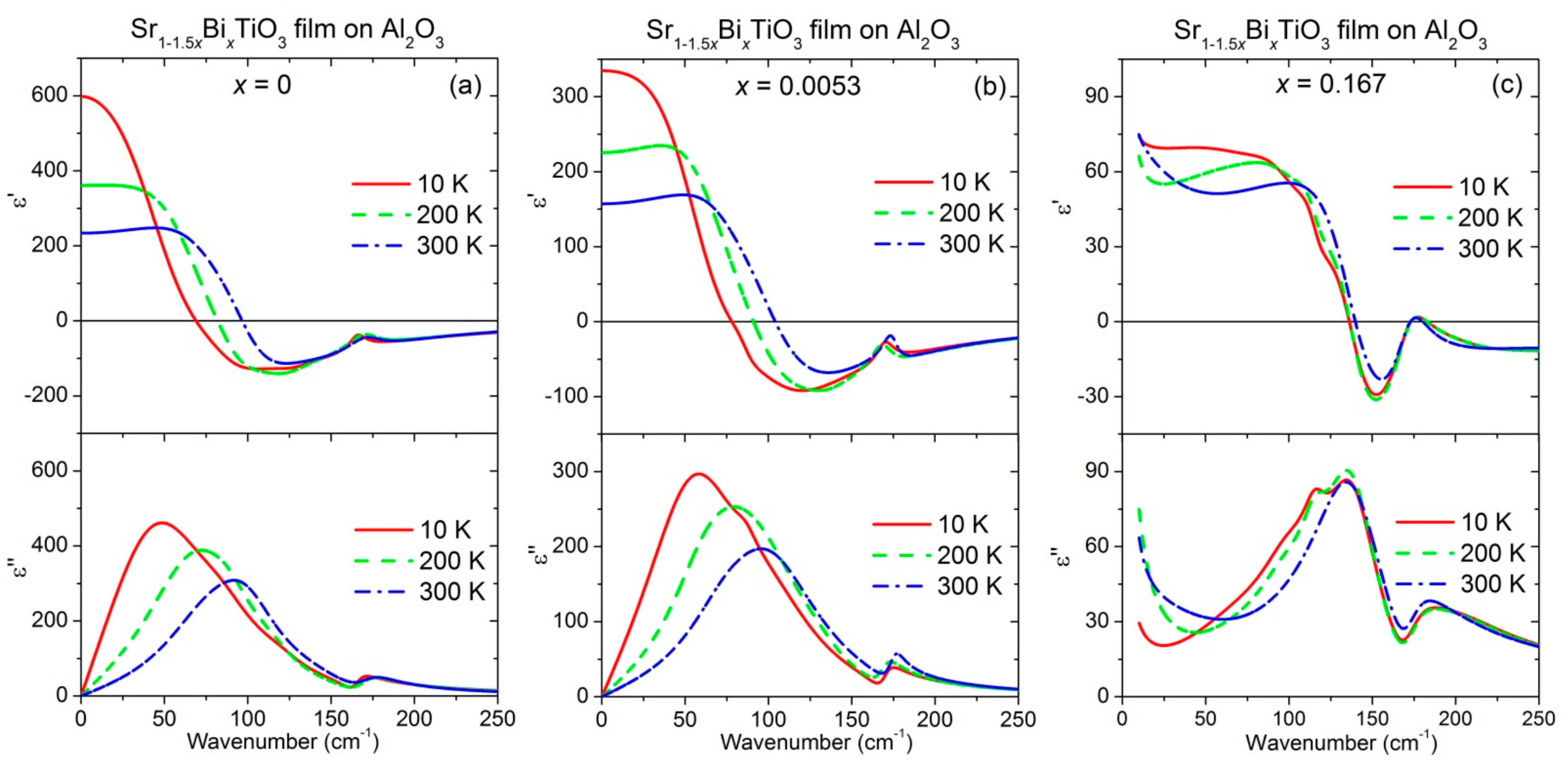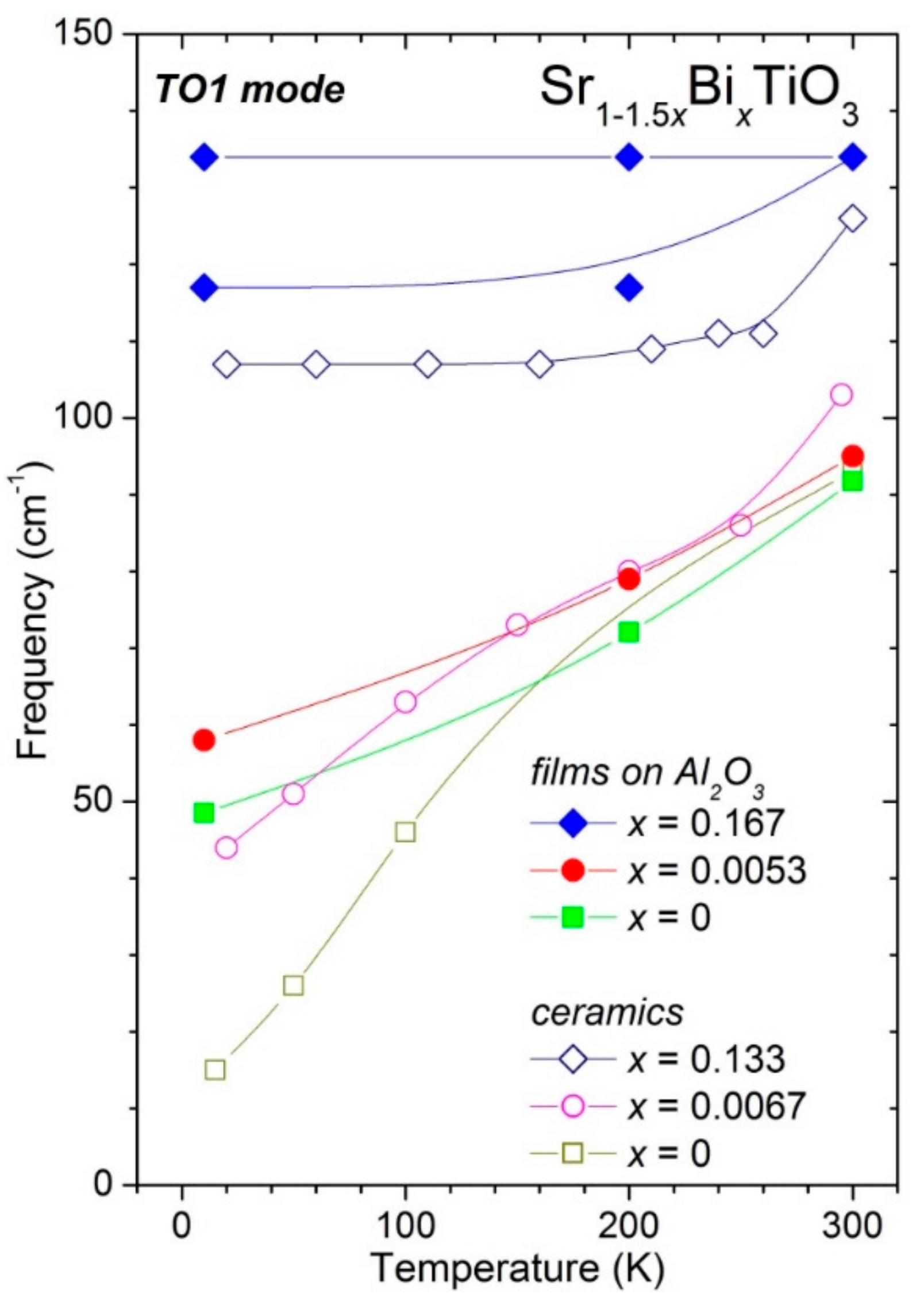Polar Phonon Behaviour in Polycrystalline Bi-Doped Strontium Titanate Thin Films
Abstract
1. Introduction
2. Materials and Methods
3. Results and Discussion
4. Conclusions
Author Contributions
Funding
Institutional Review Board Statement
Informed Consent Statement
Data Availability Statement
Conflicts of Interest
References
- Hulm, J.K. The Dielectric Properties of some Alkaline Earth Titanates at Low Temperatures. Proc. Phys. Soc. Sect. A 1950, 63, 1184–1185. [Google Scholar] [CrossRef]
- Worlock, J.M.; Fleury, P.A. Electric Field Dependence of Optical-Phonon Frequencies. Phys. Rev. Lett. 1967, 19, 1176–1179. [Google Scholar] [CrossRef]
- Müller, K.A.; Burkard, H. SrTiO3: An intrinsic quantum paraelectric below 4 K. Phys. Rev. B 1979, 19, 3593–3602. [Google Scholar] [CrossRef]
- Petzelt, J.; Nuzhnyy, D. Soft polar phonon mode in SrTiO3 single crystals, ceramics and thin films. In Strontium Titanate: Synthesis, Properties and Uses; Tkach, A., Vilarinho, P.M., Eds.; Nova Science Publishers: New York, NY, USA, 2019; pp. 1–40. [Google Scholar]
- Kleemann, W.; Dec, J.; Tkach, A.; Vilarinho, P.M. SrTiO3–glimpses of an inexhaustible source of novel solid state phenomena. Condens. Matter 2020, 5, 58. [Google Scholar] [CrossRef]
- Geyer, R.G.; Riddle, B.; Krupka, J.; Boatner, L.A. Microwave dielectric properties of single-crystal quantum paraelectrics KTaO3 and SrTiO3 at cryogenic temperatures. J. Appl. Phys. 2005, 97, 104111. [Google Scholar] [CrossRef]
- Tagantsev, A.K.; Sherman, V.; Astafiev, K.; Venkatesh, J.; Setter, N. Ferroelectric Materials for Microwave Tunable Applications. J. Electroceramics 2003, 11, 5–66. [Google Scholar] [CrossRef]
- Defaÿ, E.; Wolozan, D.; Blanc, J.-P.; Serret, E.; Garrec, P.; Verrun, S.; Pellissier, D.; Delpech, P.; Guillan, J.; André, B.; et al. High pass filter with above IC integrated SrTiO3 high K MIM capacitors. Solid-State Electron. 2007, 51, 1624–1628. [Google Scholar] [CrossRef]
- Servoin, J.L.; Luspin, Y.; Gervais, F. Infrared dispersion in SrTiO3 at high temperature. Phys. Rev. B 1980, 22, 5501–5506. [Google Scholar] [CrossRef]
- Axe, J.D.; Harada, J.; Shirane, G. Anomalous Acoustic Dispersion in Centrosymmetric Crystals with Soft Optic Phonons. Phys. Rev. B 1970, 1, 1227–1234. [Google Scholar] [CrossRef]
- Vogt, H. Refined treatment of the model of linearly coupled anharmonic oscillators and its application to the temperature dependence of the zone-center soft-mode frequencies of KTaO3 and SrTiO3. Phys. Rev. B 1995, 51, 8046–8059. [Google Scholar] [CrossRef]
- Shirane, G.; Yamada, Y. Lattice-Dynamical Study of the 110°K Phase Transition in SrTiO3. Phys. Rev. 1969, 177, 858–863. [Google Scholar] [CrossRef]
- Rupprecht, G.; Bell, R.O.; Silverman, B.D. Nonlinearity and Microwave Losses in Cubic Strontium-Titanate. Phys. Rev. 1961, 123, 97–98. [Google Scholar] [CrossRef]
- Sirenko, A.A.; Akimov, I.A.; Fox, J.R.; Clark, A.M.; Li, H.C.; Si, W.; Xi, X.X. Observation of the first-order Raman scattering in SrTiO3 thin films. Phys. Rev. Lett. 1999, 82, 4500–4503. [Google Scholar] [CrossRef]
- Sirenko, A.A.; Akimov, I.A.; Bernhard, C.; Clark, A.M.; Hao, J.-H.; Weidong, S.; Xi, X.X. Lattice dynamical properties of SrTiO3 thin films. AIP Conf. Proceed. 2000, 535, 201–217. [Google Scholar] [CrossRef]
- Sirenko, A.A.; Bernhard, C.; Golnik, A.; Clark, A.M.; Hao, J.; Si, W.; Xi, X.X. Soft-mode hardening in SrTiO3 thin films. Nature 2000, 404, 373–376. [Google Scholar] [CrossRef]
- Gupta, S.; Katiyar, R.S. Temperature-dependent structural characterization of sol-gel deposited strontium titanate (SrTiO3) thin films using Raman spectroscopy. J. Raman Spectrosc. 2001, 32, 885–891. [Google Scholar] [CrossRef]
- Ostapchuk, T.; Petzelt, J.; Zelezny, V.; Pashkin, A.; Pokorny, J.; Drbohlav, I.; Kuzel, R.; Rafaja, D.; Gorshunov, B.P.; Dressel, M.; et al. Origin of soft-mode stiffening and reduced dielectric response in SrTiO3 thin films. Phys. Rev. B 2002, 66, 235406. [Google Scholar] [CrossRef]
- Nuzhnyy, D.; Petzelt, J.; Kamba, S.; Yamada, T.; Tyunina, M.; Tagantsev, A.K.; Levoska, J.; Setter, N. Polar phonons in some compressively stressed epitaxial and polycrystalline SrTiO3 thin films. J. Electroceramics 2008, 22, 297–301. [Google Scholar] [CrossRef][Green Version]
- Fleury, P.A.; Worlock, J.M. Electric-Field-Induced Raman Scattering in SrTiO3 and KTaO3. Phys. Rev. 1968, 174, 613–623. [Google Scholar] [CrossRef]
- Okhay, O.; Tkach, A.; Vilarinho, P.M. Effect of bismuth doping on the properties of strontium titanate thin films. In Strontium Titanate: Synthesis, Properties and Uses; Tkach, A., Vilarinho, P.M., Eds.; Nova Science Publishers: New York, NY, USA, 2019; pp. 209–257. [Google Scholar]
- Tkach, A.; Okhay, O. Comment on “Hole-pinned defect-dipoles induced colossal permittivity in Bi doped SrTiO3 ceramics with Sr deficiency”. J. Mater. Sci. Technol. 2020, 65, 151–153. [Google Scholar] [CrossRef]
- Wang, H.; Zhang, W.; Xu, J.; Liu, G.; Xie, H.; Yang, L. Resistance-switching properties of Bi-doped SrTiO3 films for non-volatile memory applications with different device structures. Bull. Mater. Sci. 2018, 41, 149. [Google Scholar] [CrossRef]
- Chen, C.; Bousnina, M.; Giovannelli, F.; Delorme, F. Influence of Bi on the thermoelectric properties of SrTiO3-δ. J. Materiomics 2018, 5, 88–93. [Google Scholar] [CrossRef]
- Skanavi, G.I.; Ksendzov, I.J.; Trigubenko, V.A.; Prokhvatilov, V.G. Relaxation polarization and losses in nonferroelectric dielectrics with high dielectric constants. Sov. Phys. JETP 1958, 6, 250–259. [Google Scholar]
- Ang, C.; Yu, Z. Dielectric relaxor and ferroelectric relaxor: Bi-doped paraelectric SrTiO3. J. Appl. Phys. 2002, 91, 1487–1494. [Google Scholar] [CrossRef]
- Porokhonskyy, V.; Pashkin, A.; Bovtun, V.; Petzelt, J.; Savinov, M.; Samoukhina, P.; Ostapchuk, T.; Pokorny, J.; Avdeev, M.; Kholkin, A.; et al. Broad-band dielectric spectroscopy of SrTiO3:Bi ceramics. Phys. Rev. B 2004, 69, 144104. [Google Scholar] [CrossRef]
- Okhay, O.; Wu, A.; Vilarinho, P.M.; Tkach, A. Dielectric relaxation of Sr1–1.5xBixTiO3 sol-gel thin films. J. Appl. Phys. 2011, 109, 064103. [Google Scholar] [CrossRef]
- Okhay, O.; Bergano, V.M.; Wu, A.Y.; Vilarinho, P.M. Bi Effect on the Microstructure and Dielectric Properties of SrTiO3 Thin Films. Mater. Sci. Forum 2006, 514–516, 245–249. [Google Scholar] [CrossRef]
- Zhao, M.; Yao, X.; Shi, P.; Wei, X.; Wu, X.; Ren, W.; Lin, P. Effect of poly(vinyl acetate) on structure and property of bismuth-doped strontium titanate thin films derived by sol–gel method. Ceram. Int. 2008, 34, 997–1001. [Google Scholar] [CrossRef]
- Shi, P.; Ren, W.; Zhao, M.; Wei, X.; Wu, X.; Chen, X.; Yao, X. Structure and dielectric properties of (Sr1−1.5xBix)TiO3 thin films. J. Appl. Phys. 2009, 105, 084104. [Google Scholar] [CrossRef]
- Okhay, O.; Wu, A.; Vilarinho, P.M.; Tkach, A. Dielectric response of polycrystalline Sr1−1.5xBixTiO3 thin films under direct current bias. Appl. Phys. Lett. 2010, 97, 062912. [Google Scholar] [CrossRef]
- Song, B.; Wu, S.; Li, F.; Chen, P.; Shen, B.; Zhai, J. Excellent energy storage density and charge-discharge performance in a novel Bi0.2Sr0.7TiO3-BiFeO3 thin film. J. Mater. Chem. C 2019, 7, 10891–10900. [Google Scholar] [CrossRef]
- Liu, Y.; Yao, M.; Yao, X. Enhancement of energy storage density achieved in Bi-modified SrTiO3 thin films by introducing a TiO2 layer. J. Alloys Compd. 2021, 882, 160668. [Google Scholar] [CrossRef]
- Fedorov, I.; Železny, V.; Petzelt, J.; Trepakov, V.; Jelinek, M.; Trtík, V.; Čerňansky, M.; Studnička, V. Far-infrared spectroscopy of a SrTiO3 thin film. Ferroelectrics 1998, 208–209, 413–427. [Google Scholar] [CrossRef]
- Okhay, O.; Tkach, A.; Nuzhnyy, D.; Petzelt, J.; Vilarinho, P.M. Polar phonons in polycrystalline SrTiO3 thin films: The role of the substrate. Ferroelectrics 2018, 532, 89–99. [Google Scholar] [CrossRef]
- Yu, Z.; Ang, C.; Vilarinho, P.M.; Mantas, P.Q.; Baptista, J.L. Dielectric relaxation behaviour of Bi: SrTiO3: I. The low temperature permittivity peak. J. Eur. Ceram. Soc. 1998, 18, 1613–1619. [Google Scholar] [CrossRef]
- Tkach, A.; Almeida, A.; Moreira, J.A.; Correia, T.M.; Chaves, M.R.; Okhay, O.; Vilarinho, P.; Gregora, I.; Petzelt, J. Enhancement of tetragonality and role of strontium vacancies in heterovalent doped SrTiO3. Appl. Phys. Lett. 2011, 98, 052903. [Google Scholar] [CrossRef]
- Petzelt, J.; Ostapchuk, T.; Gregora, I.; Rychetsky, I.; Hoffmann-Eifert, S.; Pronin, A.V.; Yuzyuk, Y.; Gorshunov, B.P.; Kamba, S.; Bovtun, V.; et al. Dielectric, infrared, and Raman response of undoped SrTiO3 ceramics: Evidence of polar grain boundaries. Phys. Rev. B 2001, 64, 184111. [Google Scholar] [CrossRef]
- Lyddane, R.H.; Sachs, R.G.; Teller, E. On the Polar Vibrations of Alkali Halides. Phys. Rev. 1941, 59, 673–676. [Google Scholar] [CrossRef]




Publisher’s Note: MDPI stays neutral with regard to jurisdictional claims in published maps and institutional affiliations. |
© 2021 by the authors. Licensee MDPI, Basel, Switzerland. This article is an open access article distributed under the terms and conditions of the Creative Commons Attribution (CC BY) license (https://creativecommons.org/licenses/by/4.0/).
Share and Cite
Tkach, A.; Okhay, O.; Nuzhnyy, D.; Petzelt, J.; Vilarinho, P.M. Polar Phonon Behaviour in Polycrystalline Bi-Doped Strontium Titanate Thin Films. Materials 2021, 14, 6414. https://doi.org/10.3390/ma14216414
Tkach A, Okhay O, Nuzhnyy D, Petzelt J, Vilarinho PM. Polar Phonon Behaviour in Polycrystalline Bi-Doped Strontium Titanate Thin Films. Materials. 2021; 14(21):6414. https://doi.org/10.3390/ma14216414
Chicago/Turabian StyleTkach, Alexander, Olena Okhay, Dmitry Nuzhnyy, Jan Petzelt, and Paula M. Vilarinho. 2021. "Polar Phonon Behaviour in Polycrystalline Bi-Doped Strontium Titanate Thin Films" Materials 14, no. 21: 6414. https://doi.org/10.3390/ma14216414
APA StyleTkach, A., Okhay, O., Nuzhnyy, D., Petzelt, J., & Vilarinho, P. M. (2021). Polar Phonon Behaviour in Polycrystalline Bi-Doped Strontium Titanate Thin Films. Materials, 14(21), 6414. https://doi.org/10.3390/ma14216414








